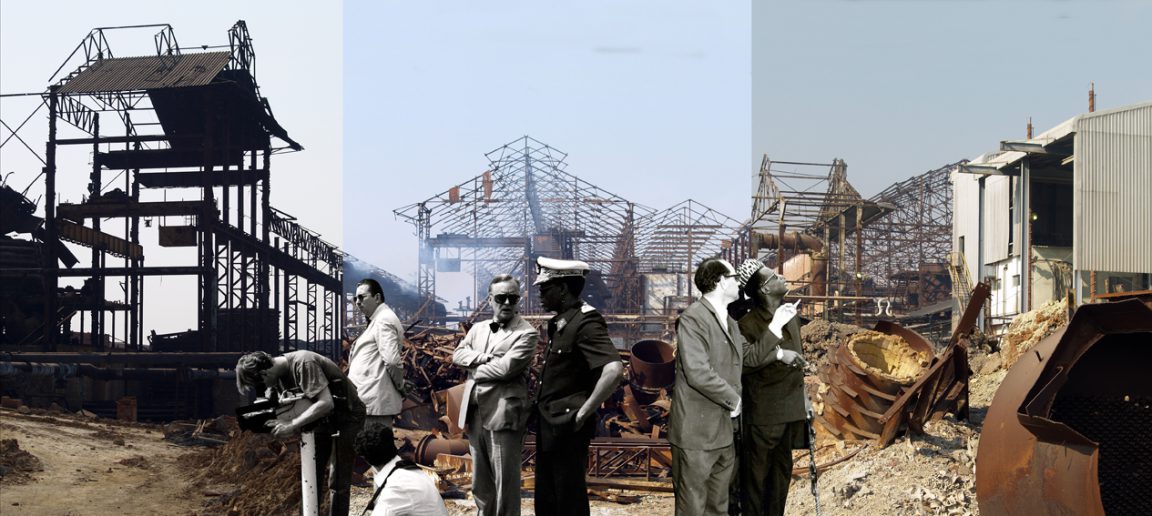Sammy Baloji

From the moment we encountered the super inspirational work of Congolese photographic artist Sammy Baloji, we haven’t been able to get his haunting imagery out of our heads ever since. In the last decade, the artist, who resides in his city of birth Lubumbashi and Brussels, has gathered international acclaim with his photographic works that explore the cultural, architectural and industrial heritage of the region where he was born named Katanga in the African country Congo. Baloji juxtaposes photographic realities, combining past and present, the real and the ideal, to illicit extraordinary cultural and historical tensions.
With his imagery Baloji explores architecture and the human body as traces of social history, sites of memory, and witnesses to operations of power. History of art and documentary photography blend with that of colonialism. His series of photomontages, of revisited albums confront his historical research with the human and economic actuality (such as the new invasions of these territories by companies from China for instance). All of his juxtapositions are highly charged with meaning, but above all: always succeed in leaving an everlasting impression, that forces one to question past, present and future of Congo and the whole continent of Africa.
The artist to MO* Magazine on living in both Congo and former colonizer Belgium:
To me it’s enriching to live in Congo on the one hand and stay in the heartland of the old colonial power on the other. Distance always creates clarity.
Sammy Baloji was born in Lubumbashi, in the mineral-rich Katanga province of Democratic Republic of Congo. He studied Computer and Information Sciences and Communication at the University of Lubumbashi. With a borrowed camera, he began photographing scenes as sources for his cartoons. He soon enrolled in photography courses in DRC, and continued with photography and video at Ecole Supérieure des Arts Décoratifs, in Strasbourg, France. Raised in the Katanga region, Sammy Baloji was sensitized to the colonial history and the postcolonial decline of the once-prosperous mining region of Congo, which (as the case in most of the former colonial African countries) Chinese companies exploit today.
It all started for the artist with his series ‘Mémoire’ (2006), that caused a rather significant cultural ripple throughout the world, and was followed by similar influential series named ‘CongoFarWest’ (2008), ‘Kolwezi'(2012), ‘Hunting and Collecting’ (2014) and most recently ‘Urban Now: City Life in Congo’ (2016). Another important moment for the artist occurred during Têtes modernes, the cycle of talks and events Chris Dercon, Director of Tate Modern, orchestrated at the Centre Pompidou in Paris, he invited Sammy and the musician he shares his name with; Baloji, to a conversation on 24 November 2012. Baloji is also co-founder of the Picha Encounters, a regular international exhibition in Lubumbashi – proof of his profound continued engagement in his home town.
Baloji has had numerous solo exhibitions at: Musée du quai Branly, Paris; MuZee, Oostende, Belgium; Royal Museum for Central Africa, Tervuren; and Museum for African Art, NY. His solo show that opened in May of last year at WIELS, Contemporary Art Center Brussels titled Sammy Baloji & Filip De Boeck — ‘Urban Now: City Life in Congo’, is now on display at the Open Society Foundation, New York, until June. Widely collected, Baloji has featured in numerous group exhibitions worldwide. He has been the recipient of numerous awards including, the Smithsonian Artist Research Fellowship, 2015,and the 2014 Rolex Mentor and Protégé Arts Initiative award, partnering with Olafur Eliasson. He was nominated a Prix Pictet finalist in 2009, received the Prince Claus Award in 2008, and two awards at the 2007 African Photography Biennial in Bamako, Mali.
All images © Sammy Baloji.
Make sure to follow Baloji’s every move through his galleries Axis Gallery and Galerie Imane Fares.













